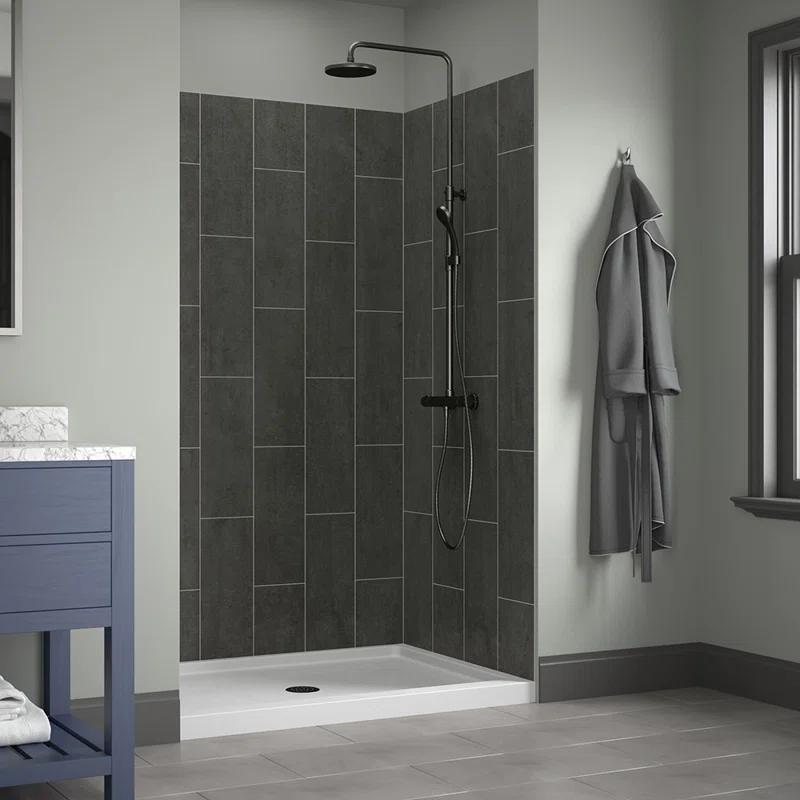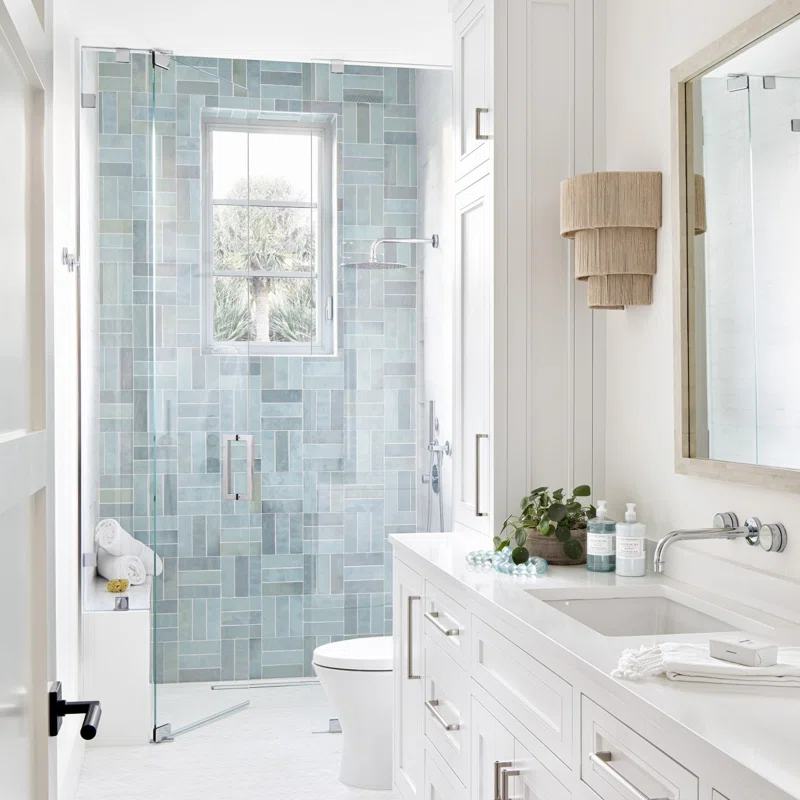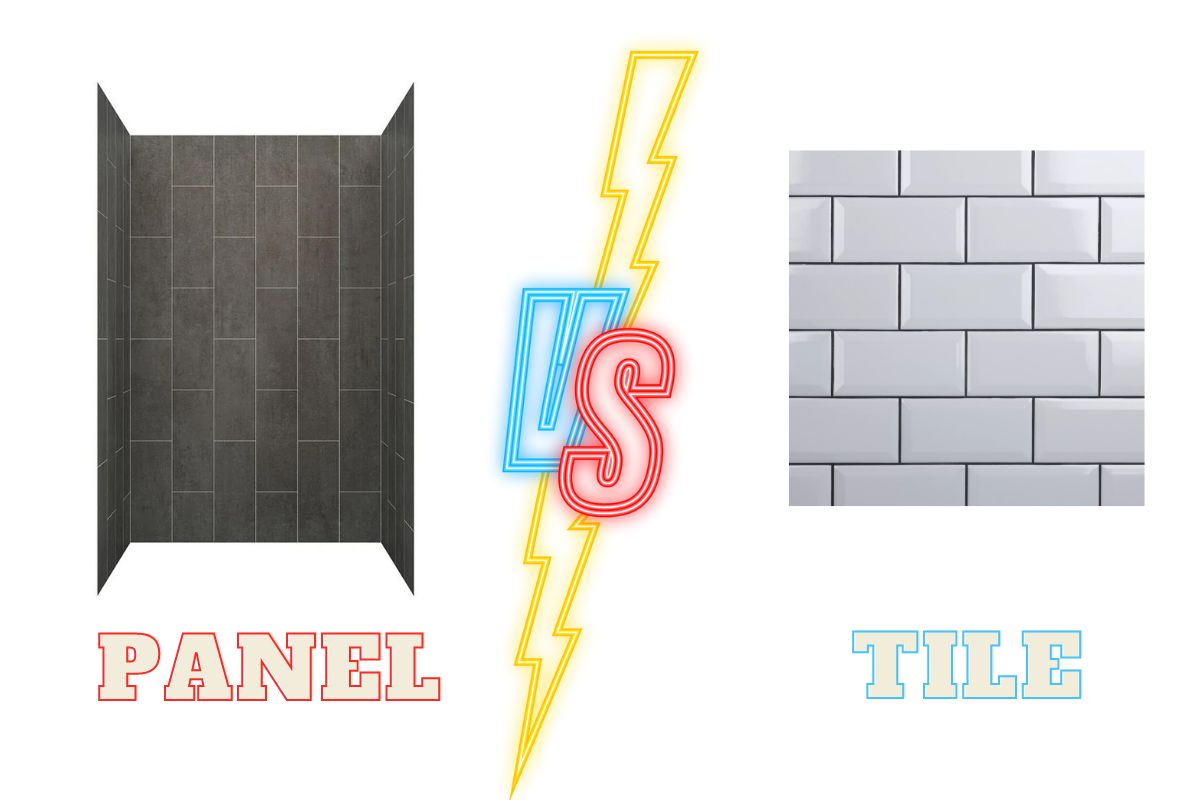When it comes to bathroom renovations, one of the main decisions you will have to make is what material to use for your shower space. Shower panels and tiles are two popular options, but which one is right for you?
Shower panels vs Tiles? It depends entirely on one’s need, the requirement of the bathroom, and budget. Both offer the same waterproofing and durability. If you want quick installation and an inexpensive solution, then go for the shower panels. However, if you want a stylish and pleasant interior, there is no match for tiles.
Further, in this blog post, we will look at both options’ pros and cons so that you can make an informed decision.
What are Shower Panels?

Shower panels are large sheets of synthetic materials (PVC, Acrylic, etc.) attached to an existing wall using adhesives. The main purpose is almost similar to the normal tiles, to protect the wall against water attack.
Shower panels are a quick and instant solution for waterproofing shower walls. They are lightweight and much more resistant to dampness. These qualities are making shower panels more common and feasible for people.
Types of Shower Panels
Shower Panels come in different sizes, lengths, and thicknesses. So, here are a few types on basis of materials.
- Fibre Reinforced Plastic: FRP panels are lightweight and thin, usually about 0.10 inches. These boards scratch easily and their color fades over time. However, they are the cheapest of all types.
- Acrylic Panels: Acrylic panels are much more scratch resistant than FRPs, and won’t discolor over time. You can also install them over tiles. However, they cost twice as FRPs.
- Laminated MDF Panels: Medium Density Fiber (MDF) coated with a lamination of vinyl are much thicker, about 3/8 inches. They provide excellent waterproofing and provide a seamless installation.
- Solid Core: Solid core boards have a solid core of Plywood or MDF with a water-resistant lamination on the outside. They are much thicker and sturdy compared to other panels.
- PVC Panels: PVC panels are also water resistant and inexpensive. However, they are thinner (a quarter of an inch) and prone to damage like FRPs.
Pros of Using Shower Panels
Shower panels offer a variety of benefits which is why they are attracting a large audience and getting more recognition in the market. Some plus points of using shower panels are stated below.
- Shower Panels are easy-to-clean and hygienic. They can easily be wiped with a piece of clothing.
- The panels come in long lengths, which can easily off cover large areas.
- No expertise or prior experience is required, you can just install it on the walls without adhesives.
- More since no mortar is involved, no drying period, hence quick installation.
- Shower panels are seamless without any grouts.
- You can easily install panels over tiled walls.
- In comparison to tiles, shower panels are considered cost-effective in a long run.
Cons of Shower Panels
Shower panels are a new technology as compared to tiles. They have a few limitations and issues which are a major concern for many people.
- Shower panels don’t offer a range of designs and color options.
- In areas with intricate shapes, panels may not be a good choice.
- A worn-out sheet can’t be repaired; it has to be replaced.
- Shower Panels are thin sheets, they don’t last long as tiles.
A brief Introduction to Tiles

Tiles are thin squares of hard covering materials like stones, and ceramics, with the characteristics of good insulation and good resistance against water attack.
Tiles are generally used for waterproofing purposes. They are rich in aesthetic properties and are considered one of the best options for bathroom walls/floors.
Pros of Using Tiles
Tiles have been the choice of people for centuries. They are still considered the best choice in the bathroom for walls & floors due to a number of advantages.
- Tiles are very durable; they last for decades.
- You will find tiles in a wide range of colors and designs.
- Tiles can easily fit in small and complex spaces without any size problems.
- You can easily clean off tiles with toilet cleaners.
- The natural designs and colors improve the overall aesthetics of your shower space.
Cons of Using Tiles
Despite being used for centuries, tiles have some flaws and weak points which are imposing people to look for new and better options.
- Tiles installation takes a long time since the mortar has a drying period and grouting is required.
- For the installation of tiles, you need a skilled professional.
- The grout lines may discolor over time, which is not a good sight.
- If the grout filling rots, there’s a likely hood of leakage.
- Since tiles installation requires time and labor, it is an expensive process.
Shower Panels vs Tiles: Comparison
Since we have already looked at the pros and cons of shower panels and tile, let’s compare them in terms of ease of installation, cost, cleaning, durability, and design.
#1 Ease of Installation
Shower panels need a few laborers for installation, or you can even install them yourselves. They are very quick to install and a large area can be covered in a day or two.
On the other hand, tiles require a greater number of skilled laborers. Installing tiles is a long-term project, each tile is to be placed separately. Furthermore, grouting needs to be done and drying of mortar takes time.
Even if you use a big-sized tile, it will still acquire more time for installing a tile in comparison compared to shower panels.
#2 Cost of Installation
The cost factor usually varies a lot with the size, quality, and quantity. But generally, shower panels are proven to be more inexpensive than tiles. Since they are DIY-friendly, if you install them themselves, you can save up some money.
Whereas, tiles normally cost a little higher than shower panels. Though some ceramic tiles are quite cheaper, labor costs and grout filling put the costs slightly above the panels.
If you are looking for a cost-effective and quick solution, shower panels are a good option to consider.
#3 Waterproofing
Since shower panels do not have any grout fillings in between them, so they are much more effective in waterproofing and protecting dry walls.
Whereas, tiles’ grout allows the water to erode itself and provide a passage to pass through it. Once the moisture enters, the walls, ceilings, and structure can be affected. Therefore, shower panels are considered a better option in terms of waterproofing.
#4 Cleaning and Maintenance
As far as cleaning is concerned, shower panels have a clear edge over tiles. Shower panels have a smooth surface with no seams or grout edges. This makes them free from dark stains and molds. They can be easily cleaned with a single wipe of a cloth or a mop. However, maintenance of a shower panel is not a feasible option. A cracked or a bit defective panel requires you to change the complete wall panel.
On the other hand, tiles have grout linings in between them. These linings are ideal for molds and other bacteria to accommodate and often discolor over time. For cleaning the tiles, special grout cleaners are required. However, if one or more tiles are damaged or broken, they can easily be removed and replaced without the need to replace the complete wall.
#5 Durability and Lifespan
Shower panels are resistant to chipping and scratches. However, the shower panels which come in short pieces can develop cracks, allowing moisture to enter the panels and possibly causing mildew development or adhesive failure. On average, a shower can easily last 10 to 15 with proper maintenance.
Tiles are vulnerable to cracking, and can easily get cracked with a stroke. But with the right maintenance, tiled shower walls last the whole lifetime of your shower. Interestingly, most people don’t have to replace their tiles at all.
#6 Design and Aesthetics
Shower panels are no match to tiles in design and aesthetics. The panels are available in a limited design and color range. They are limited to pastels such as white, blue, beige, or gray. Although some of the shower panels are molded with tile patterns, they don’t have the same appeal as real tile.
Tiles surpass shower panels with a clear margin in terms of design, versatility, aesthetics, color, pattern, and designs. Tiles are known for their appealing and aesthetic looks. Unlike shower panels, they offer fully customizable designs, colors, and pattern options.
FAQs
What materials are used in the construction of shower panels?
You will find shower panels made out of PVC, acrylic, Fiber Reinforced Plastic (FRP), Medium Density Fiber (MDF), fiberglass, and Plywood.
What is the average cost of installing a shower panel?
The average cost of installing FRB is between $200 to $400. However, for premium laminated shower panels, the cost goes up to $2000.
What is the average lifespan of a Shower panel?
On average, the shower panels can easily last for 10 to 15 years with proper maintenance and cleaning habits.
Final Words
Both shower panels and tiles possess exceptional characteristics. So, it is very difficult to state one as the winner. To choose one, you will have to consider your needs. Do you need something which is cheaper, easy to install, and waterproof? If so, you can go with shower panels. However, if you are looking to make your bathroom stylish and elegant, there is no match for tiles.

Amos Christen graduated with a bachelor’s degree in Interior Design from Drexel University — Philadelphia, PA. Since 2003, Amos has worked with top interior design professionals in this area, including architects and interior/graphic/lighting designers. As a skilled interior designer, Amos Christen is highly versed in fine arts and crafts and uses that to supplement his main area of expertise. He often publishes articles related to home décor on several websites, including Sprucetoilets.com, Sprucebathroom.com, and Mybesuitedhome.com. He also contributes to leading interior design magazines.
